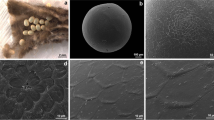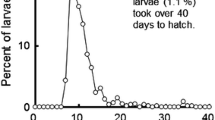Abstract
Observations on the growth and development of Chilo partellus (Swinhoe) larvae under laboratory and field conditions indicate sexual dimorphism as well as a general developmental polymorphism. Larvae of both sexes went through fifth, sixth or seventh instars before pupation. The mean developmental period, larval head capsule width, and the number of instars before pupation as well as pupal weight were higher in the female compared to the male larvae. These observations suggest differences in the physiological state of fifth-instar larvae in a population; some of them might be in the penultimate, while others might be in the ultimate instar.
Résumé
Les observations faites sur le developpement des larves du Chilo partellus (Swinhoe) ont montrés un dimorphisme sexuel ain si qui un developpement polymorphisme general. Les larves de deux sexes ont traversés le stage larvaire 5, 6 ou 7 avant la pupation. La durée moyenne du developpement de la largeur de la tête des larves le nombre des stages larvaires avant la pupation et le poids des pupes etaient plus eleves chez les femelles que ches mals. Les observations montrent des differences sur l’etat physiologique des larves du 5eme stage larvaire de la population; certaines de ces differences sont dues au stage larvaire pénultieme et les autres au stage larvaire ultime.
Mots Cléfs
k]Chilo partellus, k]stage larvaires, k]dimorphisme sexuel, k]polymorphisme developpement, k]largeur de la tête
Similar content being viewed by others
References
Caltagirone L. E. W. Getz and Meals D. W. (1983) Head capsule width as an index of age in larvae of navel orangeworm, Amyelois transitella (Lepidop-tera: Pyralidae) Environ. Ent. 12, 219–221.
Dyar H. G. (1890) The number of molts of lepidoptera larvae. Psyche 5, 420–422.
Fox R. C., Anderson N. H., Garner S. C. and Walker A. I. (1972) Larval head-capsules of the Nantucket pine tip moth. Ann. Ent. Soc. Am. 65, 513–514.
Guthrie W. D. (1981) Maize whorl stage resistance to the first four instars of European corn borer larvae (Lepidoptera:Pyralidae). J. Kansas Ent. Soc. 54, 737–740.
Lees E. and Tilley R. J. D. (1980) Influence of photoperiod and temperature on larval development in Parage aegeria (L) (Lepidoptera:Satyridae). Ent. Gaz. 31, 3–6.
Mathez F. C. (1972) Chilo partellus, Swinh., C. orichalcociliella, Strand. (Lep. Crambidae) and Sesamia calamistis Hmps. (Lep. Noctuidae) on maize in the Coast Province, Kenya. Mitt. Schweiz. Ent. Ges. 45, 167–189.
McGugan B. M. (1954) Needle-mining habits and larval instars of the spruce bud worm. Can. Ent. 86, 439–454.
Richards O. W. C. (1949) The relation between measurement of the successive instars of insects. Proc. R. Ent. Soc. London Series A 24, 8–10.
Scheites P. (1978) Ecological and physiological aspects of aestivation diapause in the larvae of two Pyralid stalk borers of maize in Kenya. Ph.D. dissertation, Landbouwhogeschool, Wageningen, The Netherlands.
Schmidt F. H., Campbell R. K. and Trotter Jr. S. J. (1977) Errors in determining instar numbers through head capsule measurements of a lepidoteran—a laboratory study and critique. Ann. Ent. Soc. Am. 70, 750–756.
Shour M. H. and Sparks T. C. (1981) Biology of the soybean looper, Pseudoplusia includens: Characterization of last-stage larva. Ann. Ent. Soc. Am. 74, 531–535.
Stairs G. R. (1965) Quantitative differences in susceptibility to nuclear-polyhedrosis virus among larval instars of the forest tent caterpillar, Malacosoma distria (Hubner), J. Invertebr. Pathol. 7, 427–429.
Van Rensburg N. J. and Hamburg H. van (1975) Grain sorghum pests: An integrated control approach. Proceedings of the First Congress of the Entomological Society of Southern Africa, pp. 151–162.
Verma K. K. and Jotwani M. G. (1983) Life processes of the stem borer Chilo partellus Swinhoe of different agro-climatic areas. Indian J. Ent. 45, 477–478.
Wada T. (1979) Influence of temperature and the growing stage of the rice plant on the number of larval instars in the rice leaf roller, Cnaphalocrocis medinalis Guenee. Jap. J. Appl. Ent. Zool. 23, 178–182.
Author information
Authors and Affiliations
Rights and permissions
About this article
Cite this article
Ampofo, J.K.O. Some Observations on Chilo partellus (Lepidoptera:Pyralidae) Developmental Biology under Field and Laboratory Conditions. Int J Trop Insect Sci 9, 271–274 (1988). https://doi.org/10.1017/S1742758400006123
Received:
Revised:
Published:
Issue Date:
DOI: https://doi.org/10.1017/S1742758400006123




